 |
 |
 |
| |
Gender-Based Differences in ART-Naives in CASTLE Study: viral response, lipids, adverse events; and Other Gender-Based Studies at IAC
|
| |
| |
Impact of Gender on Response to Lopinavir/ritonavir (LPV/r) Tablets Dosed QD or BID Administered with Tenofovir Disoproxil Fumarate (TDF) and Emtricitabine (FTC) in Antiretroviral-naive (ARV) Subjects: Results from Study M05-730
Lopinavir/ritonavir (LPV/r) in Pregnancy: ART Pregnancy Registry
Nevirapine Is Best Semen Penetrator in Study of Six PIs and Nonnucleosides
Safety, Tolerability and Efficacy of Darunavir/Ritonavir in Treatment-Experienced Women With HIV Infection: 24-Week Interim Analysis of GRACE (Gender, Race, And Clinical Experience)
Pharmacokinetics of etravirine are not affected by sex, age, race, treatment duration or use of enfuvirtide in HIV-1-infected subjects
Abbott's Kaletra(R) Tablet Dosed Once-Daily or Twice-Daily Demonstrated Similar Clinical Results Across Race and Gender Lines
PrEP for Prevention Has Arrived-Researchers Look to Daily Pill to Avert H.I.V.
Gender-Based Differences in ARV-Naive Patients Treated With Boosted Protease Inhibitors: Results From the CASTLE Study (AI424138)
Reported by Jules Levin
IAC Mexico City Aug 3-8, 2008
AUTHOR CONCLUSIONS
In treatment-naive patients, once-daily ATV/RTV demonstrated similar antiviral efficacy to twice-daily LPV/RTV, and both regimens were associated with robust increases in CD4 cell count, regardless of gender.
Once-daily ATV/RTV was associated with a lower incidence of GI-related AEs and a significantly better lipid profile than LPV/RTV, regardless of gender.
ATV/RTV is an effective once-daily boosted PI regimen that in combination with other ARVs is well tolerated and is appropriate for use in HIV-infected treatment-naive female and male patients.
INTRODUCTION
Gender-based differences in efficacy and safety have been reported among
HIV-infected individuals receiving highly active antiretroviral therapy (HAART)
and may relate to sex-based differences in pharmacokinetic and
pharmacodynamic drug handling.1-4
It has been noted that women may experience higher toxicity profiles while
receiving antiretroviral (ARV)-treatment regimens; however, data from
randomized clinical trials are limited.4,5
Women are recognized as the fastest growing population of patients with
HIV/AIDS.2
Gender differences affecting either response to, or safety of, ARV-treatment
regimens may be important to consider when selecting regimens intended for
long-term control of HIV infection, particularly among women.
Atazanavir (ATV) is a potent, generally well-tolerated, once-daily HIV-1 protease
inhibitor (PI) extensively studied in treatment-naive and treatment-experienced
patients and a common component of HAART.6,7
The CASTLE study demonstrated that in combination with tenofovir disoproxil
fumarate/emtricitabine, ATV/ritonavir (RTV) is noninferior to lopinavir (LPV)/RTV
in antiviral efficacy in treatment-naive patients at 48 weeks, with significantly
less elevation of lipids and better gastrointestinal (GI) tolerability.8
CASTLE is an international randomized clinical trial in 134 sites in 29 countries.a
This large-scale study, which included male and female HIV-infected, ARV-naive
patients, affords the opportunity to assess potential gender differences in
the efficacy and safety profiles of the 2 most commonly used PIs in HIV
treatment.
OBJECTIVE
To assess and compare the virologic, immunologic, and safety profiles of an
ATV/RTV-based regimen with an LPV/RTV-based regimen by gender using
48-week data from the CASTLE study.
METHODS
CASTLE is a randomized, open-label, prospective study comparing once-daily
ATV/RTV with twice-daily LPV/RTV, both in combination with fixed-dose
tenofovir/emtricitabine (TDF/FTC) in 883 treatment-naive HIV-infected patients
(Figure 1).
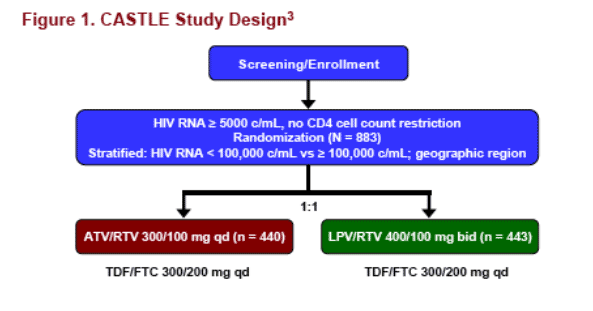
Through the first 48 weeks of the study, the protocol required patients to receive
the capsule formulation of LPV/RTV.
The primary end point was the proportion of patients with HIV RNA < 50 c/mL
at Week 48.
Secondary assessments included CD4 cell count change and safety parameters
(adverse events [AEs] and laboratory tests [eg, serum chemistry and
hematology, fasting lipid profile]).
Treatment comparisons by gender were prespecified; however, comparisons of
lipid parameters by gender were post hoc analyses.
RESULTS
Baseline patient characteristics by gender are presented in Table 1.
Of the 883 randomized patients within CASTLE, 277 patients (31%) overall were
female. Baseline characteristics were comparable by gender for both arms
(Table 1).
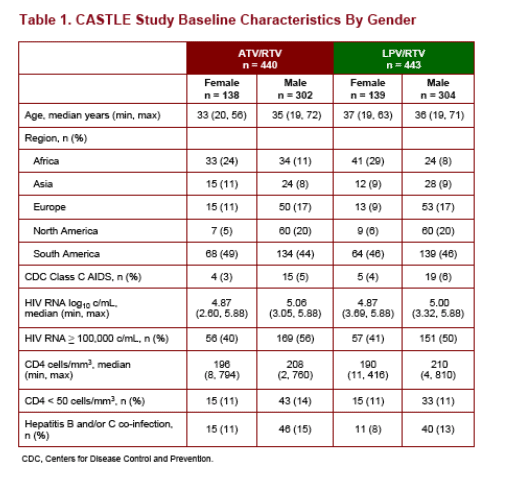
Virologic and Immunologic Responses
Overall, once-daily ATV/RTV-based HAART demonstrated similar efficacy to
twice-daily LPV/RTV-based HAART: 78% of patients on ATV/RTV and 76% on
LPV/RTV achieved HIV RNA < 50 c/mL at Week 48 (difference estimate 1.7% [95% CI, -3.8% to 7.1%]) using an intent-to-treat (ITT) analysis, confirmed virologic response (CVR) noncompleter = failure (NC = F).
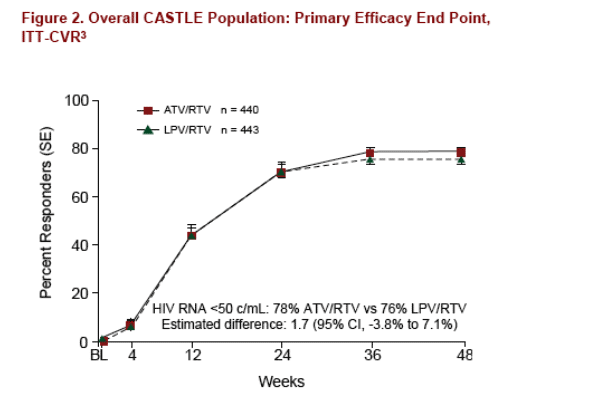
Virologic response rates were consistently high in both male and female patients
(Table 2).
Overall, mean CD4 cell count changes from baseline at Week 48 were
203 cells/mm3 on ATV/RTV and 219 cells/mm3 on LPV/RTV. These results
were consistent in both male and female patients (Table 2).
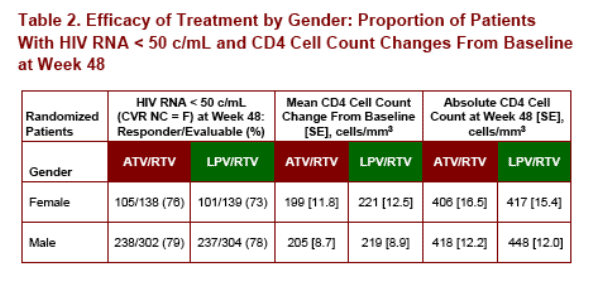
Adverse Events
AEs were not treatment-limiting in most cases.
The rates of select GI grade 2 to 4 treatment-related AEs, by gender and treatment arm, are shown in Table 3.
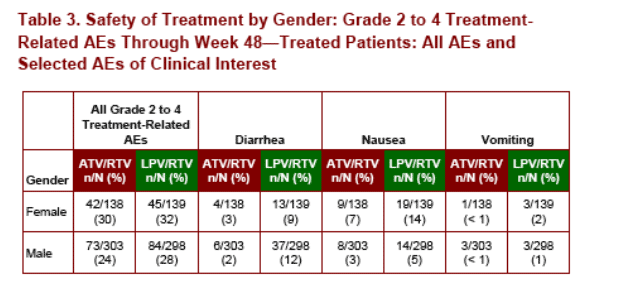
GI adverse events generally occurred at higher frequencies in patients on the
LPV/RTV rather than the ATV/RTV regimen.
In the LPV/RTV-treatment group there appeared to be a tendency for women to
experience more nausea and men to experience more diarrhea.
Other grade 2 to 4 treatment-related GI AEs were reported by ≦ 1% of men or
women in either treatment arm through 48 weeks.
Grade 2 to 4 treatment-related jaundice was reported in 4% of male patients and
3% of female patients receiving ATV/RTV, and in no patients receiving LPV/RTV.
The rates of other grade 2 to 4 treatment-related AEs differed less than 5%
between genders within system organ class for both regimens.
Lipid Parameters
Differences have been reported between ATV/RTV and LPV/RTV at 48 weeks in
the overall CASTLE population in terms of changes in lipid profile from baseline.8
-- Mean percent increases in fasting total cholesterol, non–high-density lipoprotein cholesterol (non–HDL-C), and triglycerides (TGs) were higher with LPV/RTV than ATV/RTV (all P < 0.0001).
-- More patients taking LPV/RTV (8%) than ATV/RTV (2%) initiated lipid-lowering
therapy.
Post hoc analyses of 48-week data show that the changes in fasting total
cholesterol, non–HDL-C, and TGs remained lower on ATV/RTV than LPV/RTV,
regardless of gender (Table 4).
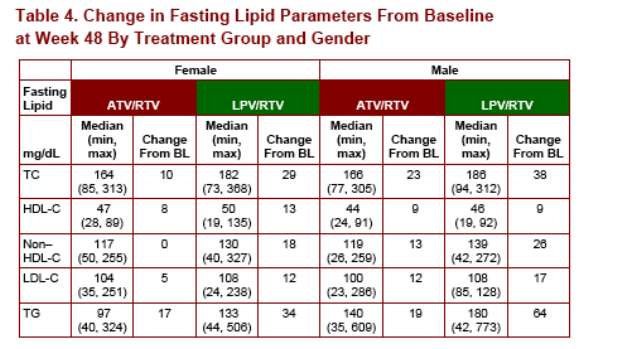
REFERENCES
1. Clark RA, Squires KE. Expert Rev Anti Infect Ther. 2005;3(2):213-27.
2. Cohn SE. AIDS Read. 2003;13(5):241-2, 244.
3. Gandhi M, et al. Annu Rev Pharmacol Toxicol. 2004;44:499-523.
4. Rodriguez-Novoa S, et al. AIDS Rev. 2005;7(2):103-12.
5. Tedaldi EM, et al. J Acquir Immune Defic Syndr. 2008;47(4):441-8.
6. Johnson M, et al. AIDS. 2006;20(5):711-8.
7. Malan DR, et al. J Acquir Immune Defic Syndr. 2008;47(2):161-7.
8. Molina JM, et al. Presented at: 15th Conference on Retrovirus and Opportunistic Infections (CROI); February 3-6, 2008; Boston, MA.
aCountries of research: Argentina, Australia, Austria, Belgium, Brazil, Canada,
Chile, Colombia, Costa Rica, Dominican Republic, France, Germany, Guatemala, Hong Kong, Indonesia, Mexico, The Netherlands, Panama, Peru, Portugal, Puerto Rico, Singapore, South Africa, Spain, Taiwan, Province of China, Thailand, United Kingdom, United States.
|
| |
|
 |
 |
|
|